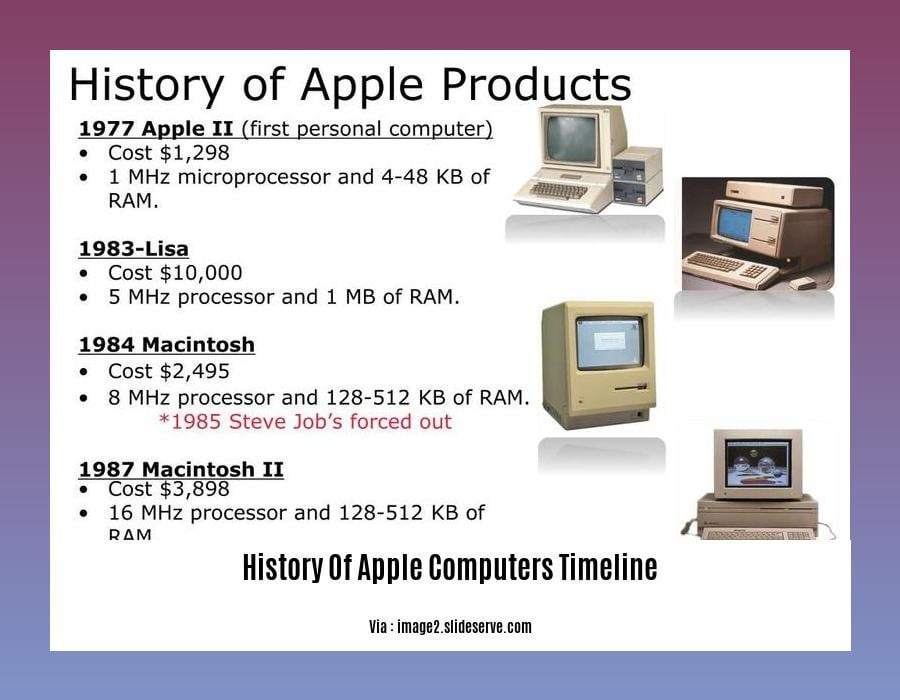Prepare to embark on a fascinating journey through time as we delve into the captivating history of Apple computers. From the early innovations of the 1970s, through the groundbreaking advancements of the 1990s, to the iconic products that redefined the 2000s, and finally, the wearable tech revolution of the 2010s and beyond, this article will take you on a nostalgic ride through the decades as we uncover the stories behind the company that revolutionized technology and left an indelible mark on our world: Apple Computers.
Key Takeaways:
- 1976: Apple released the Apple I, their debut computer.
- 1977: Apple II was introduced and became a popular personal computer.
- Early 1980s: Apple III and Apple Lisa were released but did not achieve the success of the Apple II.
- 1984: Apple introduced the Macintosh, the first successful personal computer with a graphical user interface.
- 1989: Apple released the Macintosh Portable, their first laptop computer.
History of Apple Computers Timeline: Navigating Innovation Through the Decades

From the humble beginnings of the Apple I to the sleek sophistication of the latest MacBook Pro, Apple Computers has etched an indelible mark on the landscape of personal computing. Let’s embark on a nostalgic journey through the history of Apple Computers Timeline, revisiting key milestones that shaped the tech giant we know today.
The Dawn of Apple: 1976-1980
In 1976, the dynamic duo Steve Jobs and Steve Wozniak unveiled the Apple I, a groundbreaking personal computer that kickstarted the Apple legacy. It was followed by the Apple II in 1977, a user-friendly machine that catapulted Apple to the forefront of the personal computing revolution. The Apple II’s versatility and ease of use made it a favorite among hobbyists, educators, and businesses alike, cementing Apple’s position as an industry trailblazer.
The Macintosh Era: 1984-1990
The year 1984 marked a pivotal moment in the history of Apple Computers Timeline with the introduction of the Macintosh. This revolutionary machine introduced the world to the graphical user interface (GUI), forever changing the way we interact with computers. With its sleek design, intuitive interface, and powerful capabilities, the Macintosh revolutionized personal computing and set the stage for the digital era we live in today.
Ups and Downs: The 1990s
The 1990s brought both triumphs and tribulations for Apple. The Power Macintosh line extended the legacy of the Macintosh, delivering increased processing power and advanced features. However, missteps like the over-engineered Newton MessagePad and the costly PowerPC transition led to financial challenges. Despite these setbacks, Apple remained steadfast in its pursuit of innovation, laying the groundwork for a remarkable comeback.
The iRevolution: 1997-2007
With the return of Steve Jobs in 1997, Apple embarked on a remarkable resurgence. The introduction of the iMac in 1998 marked a design revolution, capturing the world’s attention with its vibrant colors and sleek form factor. This was followed by a string of iconic products that transformed entire industries: the iPod in 2001 revolutionized portable music, the iPhone in 2007 redefined mobile communication, and the App Store in 2008 opened up a world of possibilities for app developers.
The Post-Jobs Era: 2011-Present
Following the passing of Steve Jobs in 2011, Apple continued to innovate under the leadership of Tim Cook. The iPad, introduced in 2010, created a new category of mobile computing, while the Apple Watch, launched in 2015, redefined the smartwatch market. Apple’s focus on design, user experience, and ecosystem integration has propelled the company to unprecedented heights, solidifying its position as a global technology powerhouse.
As we reflect on the history of Apple Computers Timeline, it’s evident that the company’s relentless pursuit of innovation, coupled with its commitment to user-centric design, has been the driving force behind its enduring success. From the humble origins of the Apple I to the cutting-edge marvels of today, Apple’s journey has been a testament to the transformative power of technology and the enduring vision of its founders.
- Explore how Apple’s journey unfolded over the years through this comprehensive history of Apple Inc. timeline.
- Dive into the history of art with this vibrant and informative history of art timeline poster that spans different genres and periods.
- Embark on a musical voyage with the history of bachata and uncover the captivating blend of African and Spanish rhythms that brought this genre to life.
2001 – 2009: Dominating the Market with Iconic Products

In the early 2000s, Apple, under the visionary leadership of Steve Jobs, embarked on a remarkable journey of innovation and success. This era marked a period of significant product launches and strategic initiatives that catapulted the company to the forefront of the technology industry.
The iPod Revolution
In 2001, Apple unveiled the iPod, a portable music player that revolutionized the way people listened to music. The device’s sleek design, intuitive interface, and massive storage capacity quickly captured the attention of consumers, making it an instant hit. The iPod’s popularity fueled the growth of the digital music market and established Apple as a dominant player in the industry.
The iTunes Music Store: A Digital Music Revolution
In 2003, Apple launched the iTunes Music Store, an online platform that allowed users to purchase and download music digitally. The store offered a vast selection of songs, including both mainstream and independent artists. The iTunes Music Store transformed the music industry by providing consumers with a convenient and accessible way to build their digital music libraries.
The iPhone: A Revolutionary Mobile Device
2007 marked the arrival of the iPhone, a device that would redefine the mobile phone industry. With its innovative multi-touch interface, web browsing capabilities, and a built-in music player, the iPhone set a new standard for smartphones. The device’s popularity skyrocketed, and it quickly became a must-have gadget for consumers worldwide.
Apple’s Retail Strategy: A Unique Shopping Experience
Apple’s retail strategy played a crucial role in the company’s success during this era. The company’s Apple Stores offered a unique customer experience, with knowledgeable staff, hands-on product demonstrations, and a sleek, modern design. These stores were not just places to buy Apple products; they were destinations where consumers could explore, learn, and be inspired.
Key Takeaways:
- iPod: Revolutionized the music industry with its sleek design and intuitive interface.
- iTunes Music Store: Offered a vast selection of digital music, transforming the way people consumed music.
- iPhone: Redefined the mobile phone industry with its multi-touch interface and groundbreaking features.
- Apple Stores: Provided a unique customer experience, enhancing the brand’s image and driving sales.
Citations:
1. Apple Inc. – Wikipedia
2. iPod – Wikipedia
2010 – 2019: The Rise of Wearable Tech and Beyond
Wearable technology made a significant surge in popularity during the 2010–2019 decade, transforming the way people interacted with technology. From the introduction of smartwatches to the rise of fitness trackers, this era marked a period of innovation and disruption in the tech industry.
Key Takeaways:
-
Smartwatches Take Center Stage: The Apple Watch, launched in 2015, revolutionized the smartwatch market with its sleek design, intuitive interface, and diverse functionality.
-
Fitness Trackers Gain Momentum: Fitness trackers like the Fitbit emerged as popular choices for health-conscious individuals, providing real-time tracking of steps taken, calories burned, and sleep patterns.
-
Wearables Beyond Watches: Wearable tech extended beyond watches, with devices like Google Glass (2013) attempting to introduce smart glasses, while companies like Samsung and Huawei released smart earbuds with advanced features.
-
Integration with Smartphones: Wearables seamlessly integrated with smartphones, allowing users to receive notifications, control music, and access various apps right from their wrists.
-
Challenges and Privacy Concerns: The rise of wearables also raised concerns about data privacy and security, as these devices collected and transmitted personal health and activity information.
Wearable Tech’s Impact on Our Lives
The 2010–2019 decade witnessed the rise of wearable technology, which had a profound impact on our daily lives:
-
Convenience and Efficiency: Wearables offered convenience and efficiency by providing instant access to information, notifications, and controls without the need to掏出手机.
-
Health and Fitness: Fitness trackers encouraged healthier lifestyles by promoting physical activity and providing personalized insights into fitness goals.
-
Fashion and Style: Wearables became fashion statements, with various designs and styles catering to different preferences and occasions.
-
Innovation and Future Potential: The rapid advancements in wearable technology during this period laid the groundwork for future innovations and possibilities.
Conclusion
The 2010–2019 decade marked a turning point for wearable technology, with the introduction of groundbreaking devices like the Apple Watch and the rise of fitness trackers. The integration of wearables with smartphones and the focus on health and convenience transformed the way people interacted with technology. As we move forward, the future of wearable tech holds even greater potential for innovation and integration into our daily lives.
Citations:
[1] The History of Wearable Technology
[2] The Complete History of Wearable Technology: A Timeline
FAQ
Q1: What were some of the challenges that Apple faced in the late 1990s?
A1: In the late 1990s, Apple faced several challenges, including declining market share, financial losses, and a lack of innovation. The company was also criticized for its high prices and its closed ecosystem.
Q2: How did Steve Jobs’ return to Apple in 1997 impact the company?
A2: Steve Jobs’ return to Apple in 1997 marked a turning point for the company. He introduced several successful products, such as the iPod, iTunes Music Store, and iPhone, which helped revitalize the brand and increase market share. Jobs also made significant changes to the company’s culture and operations, which helped to streamline and improve efficiency.
Q3: What are some of the factors that contributed to Apple’s success in the 2000s?
A3: Apple’s success in the 2000s was due to several factors, including the introduction of successful products such as the iPod, iTunes Music Store, and iPhone. The company also benefited from its strong brand identity, its focus on innovation, and its effective marketing campaigns.
Q4: How has Apple’s focus on wearable technology impacted the company in recent years?
A4: Apple’s focus on wearable technology has helped the company to diversify its product line and attract new customers. The Apple Watch, in particular, has been a successful product for the company, and it has helped to position Apple as a leader in the wearable tech market.
Q5: What are some of the challenges that Apple may face in the future?
A5: Some of the challenges that Apple may face in the future include increased competition from other tech companies, changing consumer preferences, and the need to continue to innovate. The company may also face challenges related to its supply chain and its reliance on China for manufacturing.
- Jerry McSorley’s Post-Divorce Life: New Beginnings - July 16, 2025
- The Rise and Fall of the New Haven Nighthawks: A Minor League Hockey Legacy - July 16, 2025
- Unlock Jerry McSorley’s Career Highlights: Eye Tax Inc.’s Solar Success - July 16, 2025


![Unveiling Apple's Legacy: A Comprehensive Timeline of Innovation [apple company history timeline] apple-company-history-timeline_2](https://www.lolaapp.com/wp-content/uploads/2023/12/apple-company-history-timeline_2-150x150.jpg)



![The Evolution of the Apple Store: A Comprehensive Timeline of Retail Innovation [Apple Store History Timeline] apple-store-history-timeline_2](https://www.lolaapp.com/wp-content/uploads/2023/12/apple-store-history-timeline_2-150x150.jpg)









